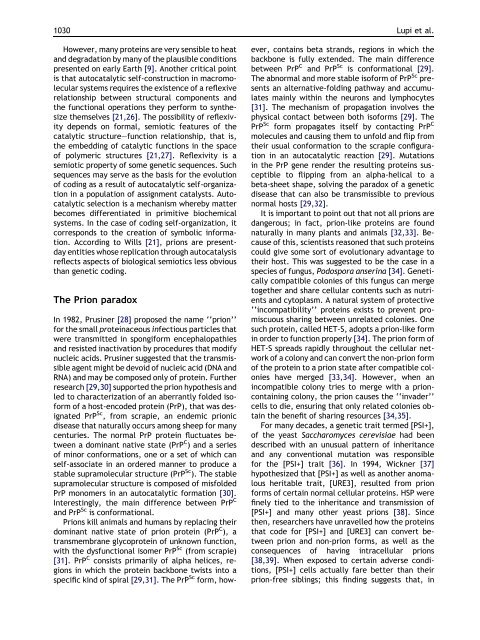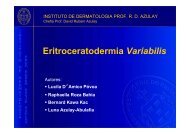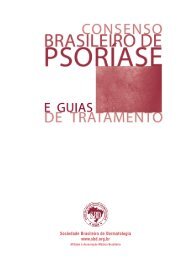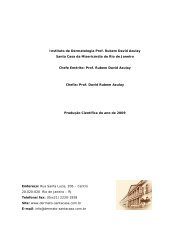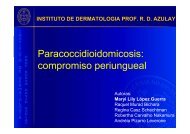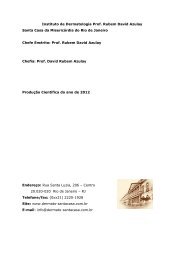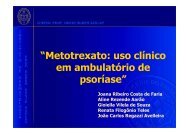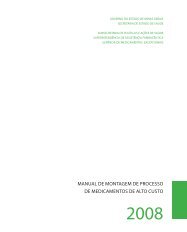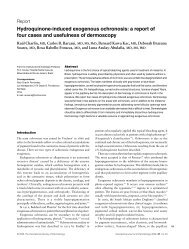Are prions related to the emergence of early life? - instituto de ...
Are prions related to the emergence of early life? - instituto de ...
Are prions related to the emergence of early life? - instituto de ...
You also want an ePaper? Increase the reach of your titles
YUMPU automatically turns print PDFs into web optimized ePapers that Google loves.
1030 Lupi et al.<br />
However, many proteins are very sensible <strong>to</strong> heat<br />
and <strong>de</strong>gradation by many <strong>of</strong> <strong>the</strong> plausible conditions<br />
presented on <strong>early</strong> Earth [9]. Ano<strong>the</strong>r critical point<br />
is that au<strong>to</strong>catalytic self-construction in macromolecular<br />
systems requires <strong>the</strong> existence <strong>of</strong> a reflexive<br />
relationship between structural components and<br />
<strong>the</strong> functional operations <strong>the</strong>y perform <strong>to</strong> syn<strong>the</strong>size<br />
<strong>the</strong>mselves [21,26]. The possibility <strong>of</strong> reflexivity<br />
<strong>de</strong>pends on formal, semiotic features <strong>of</strong> <strong>the</strong><br />
catalytic structure–function relationship, that is,<br />
<strong>the</strong> embedding <strong>of</strong> catalytic functions in <strong>the</strong> space<br />
<strong>of</strong> polymeric structures [21,27]. Reflexivity is a<br />
semiotic property <strong>of</strong> some genetic sequences. Such<br />
sequences may serve as <strong>the</strong> basis for <strong>the</strong> evolution<br />
<strong>of</strong> coding as a result <strong>of</strong> au<strong>to</strong>catalytic self-organization<br />
in a population <strong>of</strong> assignment catalysts. Au<strong>to</strong>catalytic<br />
selection is a mechanism whereby matter<br />
becomes differentiated in primitive biochemical<br />
systems. In <strong>the</strong> case <strong>of</strong> coding self-organization, it<br />
corresponds <strong>to</strong> <strong>the</strong> creation <strong>of</strong> symbolic information.<br />
According <strong>to</strong> Wills [21], <strong>prions</strong> are presentday<br />
entities whose replication through au<strong>to</strong>catalysis<br />
reflects aspects <strong>of</strong> biological semiotics less obvious<br />
than genetic coding.<br />
The Prion paradox<br />
In 1982, Prusiner [28] proposed <strong>the</strong> name ‘‘prion’’<br />
for <strong>the</strong> small proteinaceous infectious particles that<br />
were transmitted in spongiform encephalopathies<br />
and resisted inactivation by procedures that modify<br />
nucleic acids. Prusiner suggested that <strong>the</strong> transmissible<br />
agent might be <strong>de</strong>void <strong>of</strong> nucleic acid (DNA and<br />
RNA) and may be composed only <strong>of</strong> protein. Fur<strong>the</strong>r<br />
research [29,30] supported <strong>the</strong> prion hypo<strong>the</strong>sis and<br />
led <strong>to</strong> characterization <strong>of</strong> an aberrantly fol<strong>de</strong>d is<strong>of</strong>orm<br />
<strong>of</strong> a host-enco<strong>de</strong>d protein (PrP), that was <strong>de</strong>signated<br />
PrP Sc , from scrapie, an en<strong>de</strong>mic prionic<br />
disease that naturally occurs among sheep for many<br />
centuries. The normal PrP protein fluctuates between<br />
a dominant native state (PrP C ) and a series<br />
<strong>of</strong> minor conformations, one or a set <strong>of</strong> which can<br />
self-associate in an or<strong>de</strong>red manner <strong>to</strong> produce a<br />
stable supramolecular structure (PrP Sc ). The stable<br />
supramolecular structure is composed <strong>of</strong> misfol<strong>de</strong>d<br />
PrP monomers in an au<strong>to</strong>catalytic formation [30].<br />
Interestingly, <strong>the</strong> main difference between PrP C<br />
and PrP Sc is conformational.<br />
Prions kill animals and humans by replacing <strong>the</strong>ir<br />
dominant native state <strong>of</strong> prion protein (PrP C ), a<br />
transmembrane glycoprotein <strong>of</strong> unknown function,<br />
with <strong>the</strong> dysfunctional isomer PrP Sc (from scrapie)<br />
[31]. PrP C consists primarily <strong>of</strong> alpha helices, regions<br />
in which <strong>the</strong> protein backbone twists in<strong>to</strong> a<br />
specific kind <strong>of</strong> spiral [29,31]. The PrP Sc form, how-<br />
ever, contains beta strands, regions in which <strong>the</strong><br />
backbone is fully exten<strong>de</strong>d. The main difference<br />
between PrP C and PrP Sc is conformational [29].<br />
The abnormal and more stable is<strong>of</strong>orm <strong>of</strong> PrP Sc presents<br />
an alternative-folding pathway and accumulates<br />
mainly within <strong>the</strong> neurons and lymphocytes<br />
[31]. The mechanism <strong>of</strong> propagation involves <strong>the</strong><br />
physical contact between both is<strong>of</strong>orms [29]. The<br />
PrP Sc form propagates itself by contacting PrP C<br />
molecules and causing <strong>the</strong>m <strong>to</strong> unfold and flip from<br />
<strong>the</strong>ir usual conformation <strong>to</strong> <strong>the</strong> scrapie configuration<br />
in an au<strong>to</strong>catalytic reaction [29]. Mutations<br />
in <strong>the</strong> PrP gene ren<strong>de</strong>r <strong>the</strong> resulting proteins susceptible<br />
<strong>to</strong> flipping from an alpha-helical <strong>to</strong> a<br />
beta-sheet shape, solving <strong>the</strong> paradox <strong>of</strong> a genetic<br />
disease that can also be transmissible <strong>to</strong> previous<br />
normal hosts [29,32].<br />
It is important <strong>to</strong> point out that not all <strong>prions</strong> are<br />
dangerous; in fact, prion-like proteins are found<br />
naturally in many plants and animals [32,33]. Because<br />
<strong>of</strong> this, scientists reasoned that such proteins<br />
could give some sort <strong>of</strong> evolutionary advantage <strong>to</strong><br />
<strong>the</strong>ir host. This was suggested <strong>to</strong> be <strong>the</strong> case in a<br />
species <strong>of</strong> fungus, Podospora anserina [34]. Genetically<br />
compatible colonies <strong>of</strong> this fungus can merge<br />
<strong>to</strong>ge<strong>the</strong>r and share cellular contents such as nutrients<br />
and cy<strong>to</strong>plasm. A natural system <strong>of</strong> protective<br />
‘‘incompatibility’’ proteins exists <strong>to</strong> prevent promiscuous<br />
sharing between un<strong>related</strong> colonies. One<br />
such protein, called HET-S, adopts a prion-like form<br />
in or<strong>de</strong>r <strong>to</strong> function properly [34]. The prion form <strong>of</strong><br />
HET-S spreads rapidly throughout <strong>the</strong> cellular network<br />
<strong>of</strong> a colony and can convert <strong>the</strong> non-prion form<br />
<strong>of</strong> <strong>the</strong> protein <strong>to</strong> a prion state after compatible colonies<br />
have merged [33,34]. However, when an<br />
incompatible colony tries <strong>to</strong> merge with a prioncontaining<br />
colony, <strong>the</strong> prion causes <strong>the</strong> ‘‘inva<strong>de</strong>r’’<br />
cells <strong>to</strong> die, ensuring that only <strong>related</strong> colonies obtain<br />
<strong>the</strong> benefit <strong>of</strong> sharing resources [34,35].<br />
For many <strong>de</strong>ca<strong>de</strong>s, a genetic trait termed [PSI+],<br />
<strong>of</strong> <strong>the</strong> yeast Saccharomyces cerevisiae had been<br />
<strong>de</strong>scribed with an unusual pattern <strong>of</strong> inheritance<br />
and any conventional mutation was responsible<br />
for <strong>the</strong> [PSI+] trait [36]. In 1994, Wickner [37]<br />
hypo<strong>the</strong>sized that [PSI+] as well as ano<strong>the</strong>r anomalous<br />
heritable trait, [URE3], resulted from prion<br />
forms <strong>of</strong> certain normal cellular proteins. HSP were<br />
finely tied <strong>to</strong> <strong>the</strong> inheritance and transmission <strong>of</strong><br />
[PSI+] and many o<strong>the</strong>r yeast <strong>prions</strong> [38]. Since<br />
<strong>the</strong>n, researchers have unravelled how <strong>the</strong> proteins<br />
that co<strong>de</strong> for [PSI+] and [URE3] can convert between<br />
prion and non-prion forms, as well as <strong>the</strong><br />
consequences <strong>of</strong> having intracellular <strong>prions</strong><br />
[38,39]. When exposed <strong>to</strong> certain adverse conditions,<br />
[PSI+] cells actually fare better than <strong>the</strong>ir<br />
prion-free siblings; this finding suggests that, in


